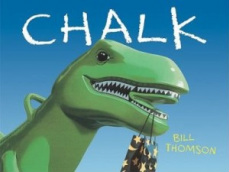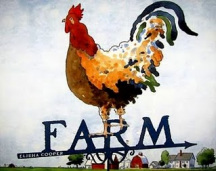
Chalk by Bill Thomson
Marshall Cavendish, 2010
On a rainy day, three children go to the park to play. When they find a bag full of sidewalk chalk and start drawing on the asphalt, they discover that whatever they draw becomes real. A sun dissipates the rain, a swarm of butterflies flies all around, and a Tyrannosaurus Rex fast becomes more terrifying than anticipated.
Wordless books are some of my favourite picture books, and Chalk is no exception. Without words, illustrations become paramount and Bill Thomson makes his acrylic and colored pencil drawings look almost like photographs: the reflections are bright and the different textures (skin, plastic, fabric) are realistic. The children's facial expressions when they discover the power of the chalk are wonderful, with one girl appearing almost crazily delighted and the boy looking very mischievous (guess who draws the carnivorous dinosaur?). I particularly loved the spread where monarch butterflies were magically taking flight from the asphalt.
Thomson uses perspective to his great advantage as well, by showing one of the frightened children fleeing up a playground ladder from below to accentuate her wide-eyed, wide-mouthed terror at being chased by a T. Rex. The perspectives he used created tension themselves, such as when the reader is in the covered slide with two of the children looking out at the dinosaur's menacing teeth, and the scene involving the demise of the T. Rex is masterfully done.
I hope Bill Thomson makes more like Chalk, as it's remarkable.
Marshall Cavendish, 2010
On a rainy day, three children go to the park to play. When they find a bag full of sidewalk chalk and start drawing on the asphalt, they discover that whatever they draw becomes real. A sun dissipates the rain, a swarm of butterflies flies all around, and a Tyrannosaurus Rex fast becomes more terrifying than anticipated.
Wordless books are some of my favourite picture books, and Chalk is no exception. Without words, illustrations become paramount and Bill Thomson makes his acrylic and colored pencil drawings look almost like photographs: the reflections are bright and the different textures (skin, plastic, fabric) are realistic. The children's facial expressions when they discover the power of the chalk are wonderful, with one girl appearing almost crazily delighted and the boy looking very mischievous (guess who draws the carnivorous dinosaur?). I particularly loved the spread where monarch butterflies were magically taking flight from the asphalt.
Thomson uses perspective to his great advantage as well, by showing one of the frightened children fleeing up a playground ladder from below to accentuate her wide-eyed, wide-mouthed terror at being chased by a T. Rex. The perspectives he used created tension themselves, such as when the reader is in the covered slide with two of the children looking out at the dinosaur's menacing teeth, and the scene involving the demise of the T. Rex is masterfully done.
I hope Bill Thomson makes more like Chalk, as it's remarkable.

 RSS Feed
RSS Feed